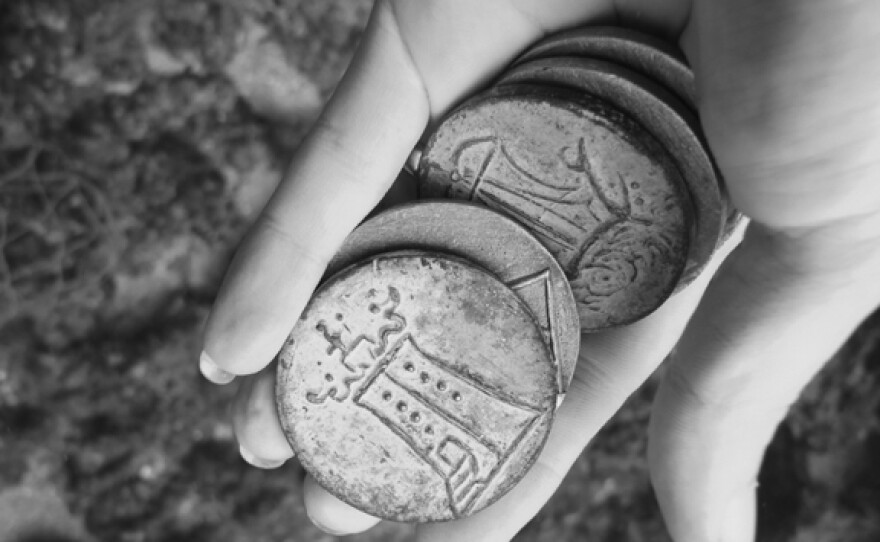There were Seven Wonders of the Ancient World, including two in Egypt: the Great Pyramid of Giza and the Lighthouse of Alexandria. You’ve probably heard of the pyramid - because it’s still standing - but the ruins of the lighthouse are underwater. For artist Ellie Ga, tracking down its remains became a quest of discovery.
An Arctic trip sheds light on a new project
"It actually starts, in a way, near the North Pole," says Ellie Ga who, in 2007, spent five months as artist-in-residence on a research sailboat called Tara. It was locked in the ice near the North Pole, charged with collecting data to study climate change, and set to drift indefinitely.
"So it was always dark, and we had no light, except for our head lamps. And, of course, we had the moon and the stars," says Ga. "I became really interested in how people on the ship dealt with this idea of the future, this uncertain future.

The future became the focus of a project called The Fortunetellers, a mix of storytelling, recorded sound, still and moving images – and it also sparked the idea for the next project.
"We finally get out of the ice, and as we’re getting out of the ice and we start sailing, the first light we see would be this light coming from the lighthouse, off the Norwegian archipelago, Svalbard," she recalls. "And it was just this very simple, facile thought, of like the future is just this light.
"It’s just this idea of being able to see something in the horizon, to hope for it, or to be scared of it. All those anxieties and dreams and desires really was symbolized in this light."
Pharos, the origin for the word 'lighthouse' across languages
The Tara was a French expedition, and while aboard the ship, Ga was learning to speak the language. In French, lighthouse is le phare, and it's similar in Spanish, el pharo, and in Italian, il pharo.
"And this would be obviously self-evident for someone who was a native speaker of a Latinate language, but for an English speaker, it is not self-evident, just that this one word is the same in all these languages. Why?" asked Ga.
When she returned to land – and access to the Internet – she found the connection was Pharos, the Lighthouse of Alexandria, one of the Seven Wonders of the Ancient World.
Built by the Greeks, the lighthouse stood for about 1500 years until a series of earthquakes reduced it to rubble by the 14th century. Some of its stones were used to build a fortress in the 15th century. And, in the mid-1990's, archaeologists also found remains on floor of the Mediterranean Sea.
The spaces between experience and perception
For the exhibition, Ellie Ga: Square, Octagon, Circle at Grand Arts, the project space in the Crossroads Arts District, three galleries display photos, drawings, writings, sculptures, and a video with Ga telling stories about living in Alexandria, Egypt from January to May 2012.
During this time, Ga studied marine archaeology, interviewed French archaeologists and Egyptian dive guides, and sent dispatches to Grand Arts called Notes from Alex. She also dove in the harbor among the stones, what was left of the ancient lighthouse.
"And when you imagine diving to see this archaeology, you imagine it’s going to be beautiful, so obvious and easy, because it’s not a very deep dive, it’s about 6 meters, like 18 to 20 feet," she says. "But the swell is so strong in that particular area, it pushes you back...so it’s hard to see your hand in front of you."

In her storytelling, performances and installations, Ga often explores what lies between experience and perception, history and memory. And through the centuries, there have been a range of interpretations of the lighthouse, including the fanciful. But she says archaeologists are trying to establish a more accurate image.
"And what they’ve come up with is three very simple shapes – square, octagon and circle – or a square, cylindrical tower and beacon," she says, and her interpretation, a minimalist brass sculpture with these three shapes, reflects this.
But – speculation still remains about the top of the lighthouse. Legends say a mirror could be used to burn enemy ships. It’s something that will, likely, never be known.
Ellie Ga: Square, Octagon, Circle, continues through October 26 at Grand Arts, 1819 Grand Blvd., Kansas City, Mo. 816-421-6887.






